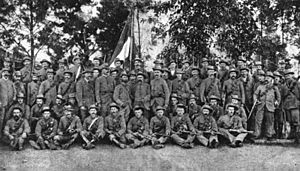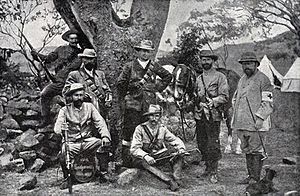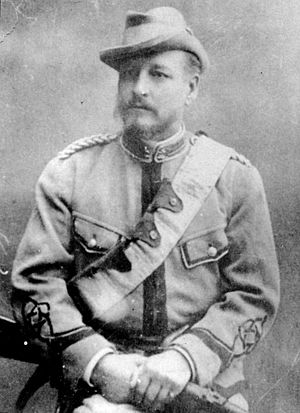Boer foreign volunteers facts for kids
Quick facts for kids Boer foreign volunteers |
|
|---|---|

Volunteers from Scandinavia in 1901
|
|
| Active | 1899–1902 |
| Allegiance | |
| Type | Commandos |
| Role | Guerilla warfare |
| Size | 5,400+ |
| Engagements | Second Boer War |
Boer foreign volunteers were people from other countries who chose to join the Boer forces during the Second Boer War. They offered their help even though their own governments did not officially support the Boers.
Contents
Why Did People Volunteer?
Many people around the world felt sympathy for the Boers. However, most governments did not want to upset the United Kingdom. This meant no country officially helped the Boers. But many individuals decided to volunteer on their own.
These volunteers came from many places, especially Europe. Countries like the Netherlands, Germany, Austria-Hungary, and Sweden-Norway sent many people. Others came from France, Italy, Ireland (which was part of the UK then), and parts of the Russian Empire. Even Finns joined the Scandinavian Corps.
Who Were the Volunteers?
Foreigners started arriving as soon as the war began. They kept coming, with hundreds joining each month. People volunteered for different reasons. Some were professional soldiers looking for adventure. Others truly believed in the Boer cause.
Some famous volunteers included:
- Ernest Douwes Dekker
- Camillo Ricchiardi
- Yevgeny Maximov
- Niko the Boer (Niko Bagrationi)
- Alexander Guchkov
- Leo Pokrowsky
- Viscount Villebois-Mareuil
- John MacBride
- John Blake
- Arthur Alfred Lynch
The foreign volunteers did not get paid for their service. The Transvaal government gave them horses, equipment, and food. Before joining, each volunteer had to promise loyalty to the Transvaal Republic.
Foreign Volunteers in the Second Boer War
The Boers did not keep detailed records of their forces during the war. Most information comes from foreigners or from the Boer commanders themselves. Here is a list of known foreign volunteers:
| Number | Nationality |
|---|---|
| 4,000 | Dutch (including Belgians) |
| 1,200 | Anglo-Irish (from the UK) |
| 550-600 | Germans |
| 400 | French |
| 300 | Irish Americans (from the U.S.) |
| 230-300 | Scandinavians |
| 200+ | Russians |
| 200 | Italians |
| unknown | Greeks |
| few | Australians |
| 7,400+ | Known total* |
At first, most foreign volunteers had to join Boer units. Later, they were allowed to form their own special groups, called foreign legions. These groups often had a lot of freedom. Some of these units included:
- Scandinavian Corps
- Italian Volunteer Legion
- Two Irish Brigades
- German Corps
- Dutch Corps
- Legion of France
- American Scouts
- Russian Scouts
Hollander Corps
Dutch volunteers created the Hollander Corps in the South African Republic. Some Belgians also joined this group in September 1899. Famous members included Herman Coster, who became a hero in the Netherlands, and Cornelis Vincent 'Cor' van Gogh, brother of the artist Vincent van Gogh. Willem Frederik Mondriaan, brother of artist Piet Mondrian, also served.
The Hollander Corps fought in the Battle of Elandslaagte in October 1899. After losing this battle, the Corps was broken up. Its members joined other Boer units. A new group, the Second Hollander Corps, formed in 1900 and joined the Orange Free State forces. A monument was built in the Netherlands to remember the Dutch who died at Elandslaagte.
The Scandinavian Corps was started by Christer Uggla, a railway engineer, when the war began in 1899. It was part of the Transvaal Boer Army. The Corps had 114 men, including officers. They came from Sweden (46), Norway (13), Denmark (24), Finland (18), Germany (7), The Netherlands (4), Russia (1), and Italy (1). Most of them were not professional soldiers, but many were sailors. An ambulance unit with four men and four women, led by Dr. Wilhelm Biedenkap, also joined the Corps.
The Corps was led by Captain Johannes Flygare (from Sweden) and lieutenants Erik Stålberg (from Sweden) and William Baerentsen (from Denmark). Only Stålberg had military experience.
The Scandinavian Corps took part in the siege of Mafeking in October and November 1899. They also fought in the Battle of Magersfontein on December 10–11, 1899. Here, they suffered heavy losses. They faced many Scottish regiments and were greatly outnumbered. The Boer soldiers were hidden in trenches and defeated the British. However, the Scandinavians were positioned far in front of the main Boer line.
The fallen soldiers were buried where they died, and several monuments were built there. One monument reads: "They could not turn back, they could only fall." Scandinavians who were captured were sent to prison camps in Ceylon or on Saint Helena island. After the battle, 20 new men joined the Corps, and Jens Friis from Denmark became the new Captain. The Corps was part of General Piet Cronje's Boer forces, who surrendered at Paardeberg in February 1900.
After the victory at Magersfontein, General Cronje said: "Next to God, the (Boer) Republics have the Scandinavian Corps to thank for the victory."
German Corps
Adolf Schiel led the German Corps. He was one of the Boer leaders at the Battle of Elandslaagte. Schiel was hurt in the battle and taken as a prisoner of war.
Legion of France
At first, foreign legions had a lot of freedom. But this changed after George Henri Anne-Marie Victor de Villebois-Mareuil and his small group of Frenchmen faced a disaster at Boshof. After that, all foreign volunteers were placed under the direct command of General De la Rey.
American Scouts
The American Scouts were led by John Hassell.
Italian Volunteer Legion
The Italian Volunteer Legion, led by Camillo Ricchiardi, captured an armoured train near Chieveley, Natal. Among the passengers was a young journalist named Winston Churchill. Ricchiardi saved Churchill's life by pretending not to see him throw away his pistol and unlawful ammunition.
Irish Transvaal Brigade
Irish people had supported the Boers since 1877. Many Irish politicians spoke out against Britain taking over the South African Republic. Support for the Boers remained strong in Ireland, especially after the British defeat at the Battle of Majuba Hill in 1881. An Irishman, Alfred Aylward, even advised the winning Boer General Piet Joubert in that battle.
When a second war with the Boers seemed likely, thousands of Irish people protested. In August 1899, nearly 20,000 people marched in Dublin against the planned invasion.
The Irish Transvaal Brigade was formed just before the Second Boer War began. It was made up of Irishmen who worked in the Witwatersrand area. These volunteers were given full citizenship in the Boer republics. Under the leadership of John Macbride, more volunteers from Ireland joined the brigade.
Second Irish Brigade
The Second Irish Brigade was formed in January 1900. Its members were mostly from the first Irish Transvaal Brigade. Arthur Alfred Lynch, a former journalist, became its commander. This brigade had 150 fighters from many different backgrounds, including Irish, Australian, Greek, German, Boer, and Italian members.
Polish Volunteers
It is hard to know exactly how many Polish volunteers fought in the Second Boer War. In official records, Poles were often counted as Austrians, Germans, or Russians. Also, the long and expensive journey made it difficult for many to come.
Many Poles felt sympathy for the Boers. They saw the Boers in a similar situation to Poland's own history. People in Poland collected money to help wounded Boers and the families of those who died. Polish newspapers often wrote about Boer victories. They described the Boers as peaceful, hardworking, and religious. Many Poles hoped the Boers would win. Boer general uniforms were popular carnival costumes. Shop windows showed pictures of Boer leaders, and these pictures sold very well. Because of this support, a hotel in Warsaw was even named "Pretoria."
Germany and Russia supported the Boers by sending weapons, military experts, and medical help. Among these helpers were Poles. Many Poles came on their own to defend a nation they felt was like their own. Others came as part of projects organized by Germany and Russia.
Polish names appear on lists of German volunteers. About 30 of the 800 known German volunteers had Polish-sounding last names. Two of them, Robert Jutrzenka and Ludwik Zalewski, arrived in the South African Republic years before the war. They even fought in an earlier conflict called the Jameson Raid in 1895.
Other Polish volunteers came as subjects of the Russian Tsar. These included two lieutenants, Leo Pokrowsky and Eugeniusz Augustus. They were sent to study the fighting methods of the Boers and the British. Leo Pokrowsky stayed in Africa and joined the Boer guerilla fighters, known as Bittereinders. He was so impressed by the Boers' bravery that he made their cause his own. His friends said he cared more about the Boers than many Boers themselves.
Russian Volunteers
Russia was one of the countries where support for the Boers was very strong. The war was widely covered in Russian newspapers, books, plays, and poems. Most of these supported the Boers. One Russian writer said, "Wherever you go these days you hear the same story – the Boers, the Boers and only the Boers."
The national anthem of the Transvaal was often played by Russian orchestras. Many groups were formed to collect money for the Transvaal. Churches held prayers for a Boer victory. In stories and novels, Boer fighters were shown as heroes fighting the "arrogant" British. Some inns and restaurants were even redecorated in the "Boer style" and given Afrikaans names to attract customers.
The novelist Olive Schreiner was very popular in Russia after she spoke out against the British government. Leo Tolstoy wrote in his diary that he hoped the Boers would win every day. Emperor Nicholas II also wrote that he was very interested in the war. He was happy when he heard about British defeats. Since Britain was Russia's main rival in the 1800s, many Russians naturally supported the Boers.
Many Russians supported the Boers because they saw them as traditional, religious people resisting an invasion. The Georgian Prince Niko Bagration was in Paris when the war started. He felt a strong connection to the Boer cause, even though he had never heard of the Transvaal before. Prince Bagration was welcomed in Pretoria by President Paul Kruger of the Transvaal.
Yevgeny Maximov was another important Russian volunteer. He had fought in other wars before. Maximov was known for his bravery and skill as a horseman and marksman. President Kruger thanked him for his courage. Kruger believed Maximov was representing the Russian Emperor and hoped Russia would join the war.
Some Russian volunteers were also left-wing thinkers. They joined the Boer cause because they were against imperialism.
However, some Russians who came to fight were surprised by problems in the Transvaal government. They also saw how the Boers treated Black people. One volunteer, Yevgeny Augustus, wrote that the Transvaal had become "a paradise for adventurers and rogues." Many of the Russian volunteers who arrived after the war started were separated from the Jewish volunteers who already lived in the Transvaal. Benzion Aaron, a Russian Jewish businessman, started the Jewish Ambulance Corps to help the wounded. Two Russian Jewish volunteers, Josef Segal and Wolf Jacobson, were known for their scouting skills.
Greek Volunteers
Quite a few Greeks also joined the Boers as foreign volunteers.
Australian Volunteers
Most people from Commonwealth countries fought with the British. However, a few Australians fought on the Boer side. The most famous was Colonel Arthur Alfred Lynch, from Ballarat. He formed the Second Irish Brigade. The British government charged Lynch with treason and sentenced him to death for helping the Boers. But after many people asked for his release, and with help from King Edward VII, he was freed a year later and pardoned in 1907.
Notable Foreign Volunteers
- Yevgeny Maximov
- John Y. F. Blake
- Herman Coster
- Arthur Alfred Lynch
- John MacBride
- Camillo Ricchiardi
- Adolf Schiel
- George Henri Anne-Marie Victor de Villebois-Mareuil
- Ernest Douwes Dekker
- Mahatma Gandhi



